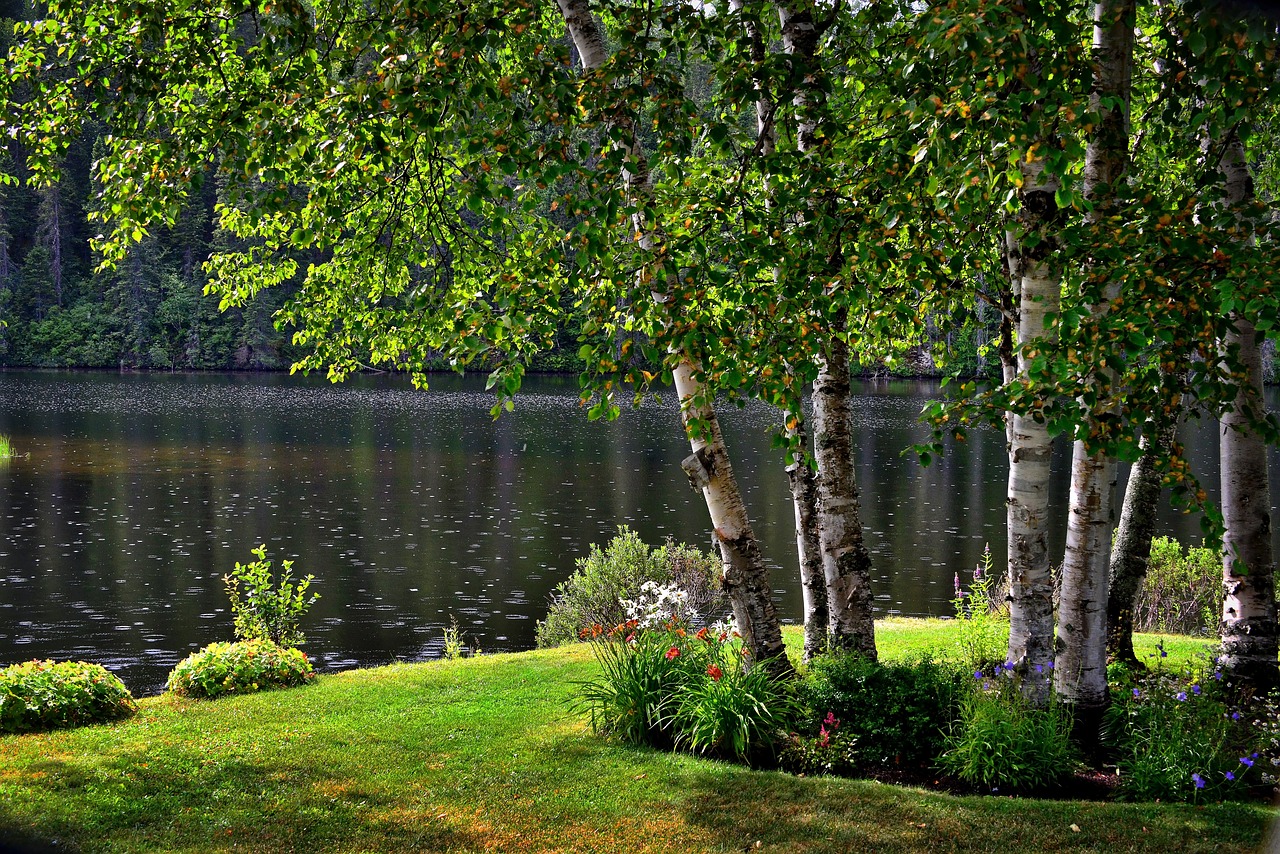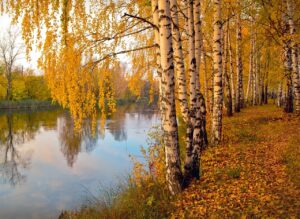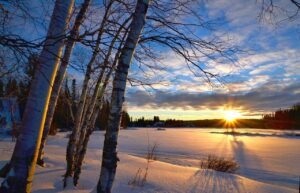Birch
Overview
Delicate and statuesque, the Birch tree (Betula genus) graces northern landscapes with its distinctive white-gray bark and rich, colorful fall foliage. Thriving in colder climates, this charming deciduous tree is a versatile addition to gardens, valued for its beauty and simplicity in care. Birch trees are known not only for their elegant shapes but also for the benefits they bring to a garden’s aesthetics and atmosphere, especially when their leaves turn vibrant hues in autumn1 4 5.

Characteristics
Known for its elegant silhouette, distinctive peeling bark, and vibrant autumn leaves.
Region
Birch trees are typically found in northern temperate and boreal climates across the Northern Hemisphere.
Natural Habitat
Birch trees are commonly found in forests, particularly in cool, northern climates.
Cultivation
Prefers cooler climates with full sun to partial shade, moist but well-drained soil; regular deep watering without over-saturation is crucial.
Uses and Benefits
Birch trees offer a wealth of benefits beyond their stunning appearance. Their distinctive bark, ranging from white-gray to reddish hues, has made them a popular choice for natural landscaping2 4. These trees are not only visually appealing but also have the ability to enhance garden ecosystems1 3.
Gardeners with an eye for design often strategically place birch trees near water features, allowing their reflections to amplify their beauty3. However, birch trees are not merely decorative. Historically, the leaves and sap of certain Betula species have been used in traditional practices for their potential health-promoting properties1.
Throughout the seasons, birch trees provide an ever-changing display:
- Early-season catkins grace the branches
- Autumn leaves burst with vibrant colors
- The trees maintain their allure even as winter approaches4
The combination of beauty, versatility, and rich lore surrounding birch trees makes them more than just another species in the landscape. They are living storytellers, deeply connected to the earth and the tales they inspire2.

Cultivation Tips
Cultivating Birch trees successfully means emulating their native habitat. These trees thrive best in cooler regions, particularly USDA zones 2 through 75. When planting Birch, select a spot with ample moisture, as they prefer moist—but not waterlogged—soil3.
To mimic the steady, natural hydration Birches receive in the wild, water them thoroughly once a week during their growing season, reaching a soil depth of 8-18 inches3. Consider the tree’s location carefully, giving them enough space to grow their canopy upwards and showcase their stunning bark, which is a major part of their appeal4.
Planting Birches near a water feature can amplify their natural beauty, as reflected by species like Betula pendula1. While these trees grow faster than many others, keep in mind that they aren’t as long-lived. Enjoy their beauty while planning for future additions to your garden space4.
To ensure your Birch trees continue to grace your garden for years to come, watch out for Birch Borers, their primary pest. Early detection and proper care can keep these pests at bay2.
Key Cultivation Tips:
- Plant in cooler regions (USDA zones 2-7)
- Choose a spot with ample moisture
- Water thoroughly once a week during growing season
- Provide enough space for canopy growth
- Consider planting near a water feature
- Monitor for Birch Borers and provide proper care
Seasonal Considerations
When cultivating Birch trees, it’s crucial to consider the seasonal changes and how they affect the tree’s growth and health. In the spring, Birch trees begin to leaf out and grow actively, requiring ample moisture and nutrients to support their development. During this time, ensure that the soil remains moist but well-drained, as Birches are susceptible to root rot in waterlogged conditions.
As summer arrives, Birch trees continue to grow and thrive in the warmer temperatures. However, they may require more frequent watering during extended periods of heat or drought to prevent stress and maintain their health. Mulching around the base of the tree can help retain soil moisture and regulate temperature fluctuations.
In the fall, Birch trees prepare for dormancy by shedding their leaves and storing energy in their roots. This is an ideal time to plant new Birch trees, as the cooler temperatures and increased moisture allow for better root establishment before winter arrives.
During winter, Birch trees enter a state of dormancy, which is essential for their survival in colder climates. While dormant, they require less water and are more resilient to freezing temperatures. However, it’s still important to monitor soil moisture levels and provide additional water if necessary, especially in areas with dry winter conditions.
Throughout the year, be vigilant for signs of Birch Borers, the primary pest that affects Birch trees2. These insects are most active during the growing season, particularly in the summer months. Regularly inspect your trees for any signs of infestation, such as small holes in the bark or yellowing leaves, and take appropriate action to control the pest population if needed.
By understanding the seasonal needs of Birch trees and providing them with the proper care and attention, you can ensure that these beautiful trees remain a thriving and stunning addition to your garden for years to come.

Issues and Troubleshooting
While the enchanting beauty of birch trees is undeniable, they are not without their share of challenges. One of the most significant issues faced by birch trees is the notorious Birch Borer, a devious pest capable of inflicting substantial harm to the tree2. Swift identification and immediate treatment are crucial for effectively controlling this menace.
To safeguard the health of your birch tree, it is essential to implement a consistent watering regimen. Overly dry conditions can place undue stress on the tree, rendering it more vulnerable to infestation3 4. By ensuring that your birch receives adequate moisture, you can bolster its natural defenses and improve its overall resilience.
In addition to the Birch Borer, leaf spot diseases pose another potential threat to the well-being of your birch tree. To minimize the risk of these fungal issues, it is important to provide your birch with ample space to grow and flourish. Overcrowding can lead to increased moisture levels, creating an environment that is conducive to the development and spread of fungal problems4.
Despite these challenges, most common issues faced by birch trees can be effectively managed through attentive care and proactive measures. By remaining vigilant and addressing any concerns promptly, you can ensure that your birch tree thrives, adding a stunning and vibrant element to your garden’s landscape.
History and Folklore
Birch trees have long been cherished for their beauty and symbolism, leaving an indelible mark on the histories and folklores of cultures around the world. With their distinctive papery bark and graceful silhouettes, these trees have come to represent renewal, purification, and protection2.
In many traditions, Birch trees are seen as powerful allies against negative energies. The practice of using Birch twigs to ward off evil spirits has been passed down through generations, a testament to the tree’s enduring reputation as a guardian.
As winter gives way to spring, Birch branches have been incorporated into rituals celebrating the arrival of the new season. By bringing these branches into their homes, people invite the vitality and fresh energy of spring into their lives, embodying the Birch’s symbolism of new beginnings.
From childhood memories of climbing their sturdy trunks to mythological tales that have stood the test of time, Birch trees have become an integral part of the human story. Their presence serves as a reminder of our connection to nature and the cyclical nature of life itself.
As we continue to navigate an ever-changing world, the Birch tree remains a steadfast symbol of resilience, adaptability, and the promise of renewal. Its legacy is forever etched in the collective consciousness, a testament to the enduring power of nature to inspire and guide us.
References
1. Homes & Gardens. “Birch trees: a guide to popular species,” https://www.homesandgardens.com/advice/birch-trees
2. Morning Chores. “Birch Trees: How to Plant, Grow and Care For An American Classic,” https://morningchores.com/birch-tree/
3. Gardenia. “Birch Trees (Betula): Varieties, Care, and Landscaping Tips,” https://www.gardenia.net/genus/betula-birch
4. Gardeningetc. “Birch trees care and growing guide: expert gardening tips,” https://www.gardeningetc.com/advice/birch-trees-care-and-growing-guide
5. Leafyplace. “Birch Trees: Types, Leaves, Bark – Identification (With Pictures),” https://leafyplace.com/birch-trees/
Image Credit: AlainAudet
Image Credit: mobinovyc
Image Credit: AlainAudet
Nicolas Duval
Nicolas is a passionate advocate for nature and the art of wildcrafting. His dedication shines through in Wildcraftia, a website he meticulously crafted to serve as a haven for nature enthusiasts worldwide. Driven by a deep appreciation for nature’s connection to humanity, Nicolas embarked on his journey in 2011 with SmokableHerbs, a platform showcasing his love for nature’s bounty. Building upon this foundation, he established Smokably, a thriving online store offering premium herbs and blends to a global audience.
